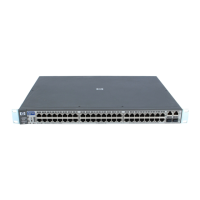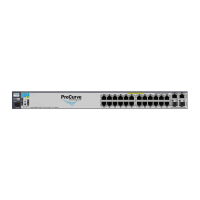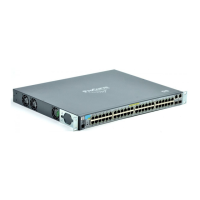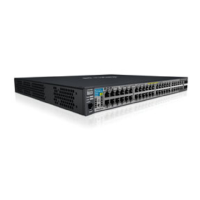9-27
Optimizing Traffic Flow with Port Controls, Port Trunking, and Port-Based Priority
Port Trunking
Default Port Operation
In the default configuration, all ports are configured for passive LACP. How-
ever, if LACP is not configured, the port will not try to detect a trunk config-
uration and will operate as a standard, untrunked port.
Note Passive and active LACP port will pause and listen for LACP packets once a
link is established. Once this pause is complete then the port, if a trunk is not
detected, will be placed in forwarding mode. Some end-node applications have
been found to be sensitive to this pause and may require LACP to be disabled
on the port.
The following table describes the elements of per-port LACP operation. To
display this data for a particular switch, execute the following command in
the CLI:
HPswitch> show lacp
Table 9-6. LACP Port Status Data
Status Name Meaning
Port Numb Shows the physical port number for each port configured for LACP operation (C1, C2, C3 . . .). Unlisted
port numbers indicate that the missing ports are assigned to a static Trunk group, an FEC trunk group,
or are not configured for any trunking.
LACP Enabled Active: The port automatically sends LACP protocol packets.
Passive: The port does not automatically send LACP protocol packets, and responds only if it receives
LACP protocol packets from the opposite device.
A link having either two active LACP ports or one active port and one passive port can perform dynamic
LACP trunking. A link having two passive LACP ports will not perform LACP trunking because both ports
are waiting for an LACP protocol packet from the opposite device.
Note: In the default switch configuration, all ports are configured for passive LACP operation.
Trunk Group TrkX: This port has been manually configured into a static LACP trunk.
Trunk Group Same as Port Number: The port is configured for LACP, but is not a member of a port trunk.
Port Status Up: The port has an active LACP link and is not blocked or in Standby mode.
Down: The port is enabled, but an LACP link is not established. This can indicate, for example, a port that
is not connected to the network or a speed mismatch between a pair of linked ports.
Disabled: The port cannot carry traffic.
Blocked: LACP, STP, or FEC has blocked the port. (The port is not in LACP Standby mode.) This may be
due to a trunk negotiation (very brief) or a configuration error such as differing port speeds on the same
link or attempting to connect the Switches 2650 and 6108 to more than six trunks.
Standby: The port is configured for dynamic LACP trunking to another device, but the maximum number
of ports for the Dynamic trunk to that device has already been reached on either the Switches 2650 and
6108 or the other device. This port will remain in reserve, or “standby” unless LACP detects that another,
active link in the trunk has become disabled, blocked, or down. In this case, LACP automatically assigns
a Standby port, if available, to replace the failed port.
!Software.book Page 27 Thursday, October 10, 2002 6:10 PM

